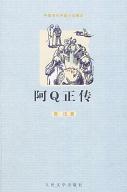“The True Story of Ah Q”, published in 1921, is Lu Xun's most celebrated work. It depicts an ignorant farm laborer, an everyman, who experiences, with an utter lack of self-awareness, a series of humiliations which he interprets as victories, and finally is unfairly executed during the chaos of the Republican revolution of 1911. Ah Q is considered the personification of the negative traits of the Chinese national character. The term A Quism was coined to signify the Chinese penchant for naming defeat a "spiritual victory." While revealing Ah Q's weakness of will, the author also shows his deep sympathy for his character. In the allegory Lu Xun sees China unprepared to deal with the impact of Western culture and technology. | 
|
His three volumes of stories, Na han (1923, Call to Arms), Pang huang (1926, Wandering), and Gu shi xin bian (1935, Old Tales Retold), deeply influenced modern Chinese fiction. However, Lu Xun and his younger brother Zhou Zuoren's translations of Western works, including stories by Leonid Andreyev, Guy de Maupassant, and Henry Sienkiewich, were received with near silence by the reading public. Besides short stories, Lu Xun published essays and a volume of childhood memories, Dawn Blossoms Plucked at Dusk. However, he never wrote a novel. Lu Xun's works exerted a very substantial influence after the May Fourth Movement to such a point that he was lionized by the Communist regime after 1949. Mao Zedong himself was a lifelong admirer of Lu Xun's works. Though sympathetic to the ideals of the Left, Lu Xun never actually joined the Chinese Communist Party - like fellow leaders of the May Fourth Movement, he was primarily a liberal. Lu Xun's works are known to English readers through numerous translations, especially Selected Stories of Lu Hsun translated by Yang Hsien-yi and Gladys Yang. |